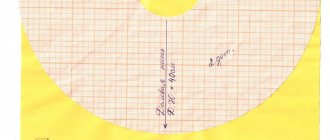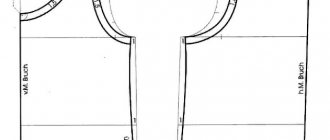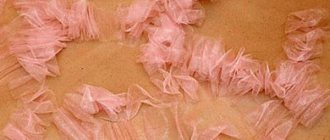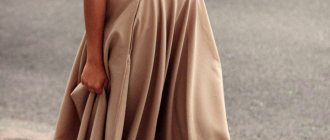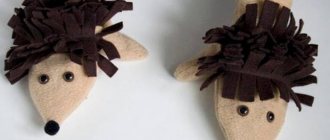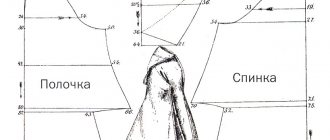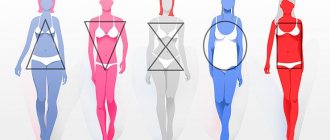Determining the size
It is necessary to take measurements with a measuring tape along the waist line. It is she who will help clarify its circumference. We need to know the length - r and the length - R. Knowing these dimensions, we can draw a circle for the sun skirt. R is a segment of the length of the skirt (add 1.5 cm to it for the hem of the bottom), r - we will calculate as shown below.
The waist circumference was 79 cm, but we need to find out the radius of this circle. Therefore, we use this formula: r = waist circumference, divide by 2 Pi. r = 79/6.28 = 12.5 cm. The resulting radius can be rounded up or down.
How to calculate the amount of fabric for a circle skirt
In order to calculate how much fabric is needed for a dress, you should remember a little about the school geometry course, the most basic knowledge. For example, you need to make a skirt with a length of 50 cm and a waist circumference of 60 cm. In this case, you will need a square-shaped fabric with a side of 120 cm. Now we will tell you why.
Let's imagine that the waist circumference is a circumference. The diameter of a circle is calculated using the formula, and it is equal to the length divided by pi. And the radius is equal to half the diameter. So it turns out that the waist radius with a girth of 60 cm is equal to 60/(2×3.14) ~ 10 cm. This size is set aside to one side and the length of the skirt itself is added to it (50 cm in our case). This gives us half the side of the square. The whole side is twice as large, that is, 1.2 meters.
IMPORTANT: at the end, to get the whole side, we double the size, because initially we set the radius and length only in one direction, without taking into account the other.
Taking measurements
No special measurements are required to create a pattern and sew. To do this, you need to know only two basic parameters of the future product. Measure your waist circumference using a measuring tape. This parameter will remain unchanged and will not play an important role in determining the required amount of material. The next size is key, and the size of the future product largely depends on it. We are talking about the length of the skirt itself. You can make absolutely any length according to your wishes. Nowadays there are models from very short to incredibly large, swelling in the wind. If you use a short version, it is better to make it from thick fabric and complement the look with a wide belt. In the case of long skirts, light, airy and slightly transparent material is used, giving tenderness to the woman who wears it.
We calculate the fabric
Before creating a pattern and performing the necessary manipulations, you should carefully calculate all the dimensions and select the type of fabric you like. There is nothing complicated at this stage, just follow the instructions that were detailed above. Measure your waist circumference, calculate the radius of the inner circle from this and add the length to it. You will receive the required dimensions.
ATTENTION: it is best to take extra fabric. If there is excess length, you can very easily remove it with scissors. Use the remaining scraps to make decorative bows or a belt.
Constructing a pattern
First we mark the landing radius r. Then we mark the length of the skirt R + 1.5 cm (an increase for the bottom of the skirt for hemming). Another 0.5 cm is added to the upper cut.
After calculating r = 12.5 cm from the upper corner of the square, we measure this distance with a centimeter tape and use a pencil to put the first mark, and the other mark 54.5 cm from the upper corner, since the skirt has a length of 40 + 1.5 + 0, 5 + r = 54.5 cm.
When both radii have been marked, you need to draw two circles on paper. We take a measuring tape and from the corner of the upper square, following the marks, draw a smooth line with a pencil of length r and R.
We study step-by-step calculation of a circle skirt pattern in a master class
Taking measurements:
- Waist circumference (WC);
- Skirt length (DU).
We remember the formulas and do the calculations.
The skirt pattern - the sun is a full circle with a cutout in the middle.
The basic formula for constructing a pattern is extremely simple: L = 2? R.
- Circumference length (L) = waist circumference (WC) plus an increase for a comfortable fit.
- Number ? = 3.14. We know this from a school mathematics course.
- Let's rewrite the formula: FROM = 2? 3.14? R 1.
- We substitute known quantities into the formula. So we will calculate the figure for the radius of a small circle corresponding to the OT measure (we take into account the increase). R 1 = FROM? 6.28.
- The resulting circumference will be the waist line.
Pay attention to the photo:
The blue short arrow will be the radius of the small inner circle (R1) or the waist line.
The orange arrow symbolically indicates the length of the skirt (DL). It can only be limited by the width of the fabric.
- In a product without seams DU = ? canvas width – R 1 – 5 cm (for a loose fit).
For example, fabric width = 150 cm. Then maximum DN = 59 cm. The purple arrow indicates this in the diagram.
- Fabric consumption for the skirt - sun without seams = 2 DU + 25 cm + 4 cm (for a loose fit).
- Fabric consumption for a two-seam skirt = 4 DU + allowance for a comfortable fit.
There are many photos and video tutorials on the Internet on how to carry out calculations and cut out skirts - the sun. Videos will also be posted at the end of this article. Those interested can familiarize themselves and take them as a basis when starting work. These are simple constructions, the main thing is to understand the principles and patterns. And everything will definitely work out.
Sewing a skirt - the sun:
- Baste and stitch the side seams (if there are any).
- Leave part of the seam open for the zipper (if provided). Otherwise, a wide elastic band is threaded into the belt of the product.
- Let's attach the clasp.
- We will sew the hem of the skirt with an overlock stitch, a zigzag stitch or a hem stitch.
Important.
Fabric cut on the bias tends to stretch. To process it correctly, you need a certain skill. Therefore, it is recommended to first sweep the cut, and only then lay the stitch.
We are studying a master class on making a circle skirt for a girl
Models of children's things are simpler to make. Therefore, we will master the work by sewing a skirt for a girl with our own hands.
Materials for creativity:
- Main fabric;
- Decorative braid;
- Threads with a needle;
- Scissors;
- Sewing machine;
- Tailor's pins and chalk.
Children's size chart:
| Age | Size | Bust | Waist circumference | Height |
| 2 years | 28 | 54 cm – 56 cm | 50 cm – 53 cm | 92 cm – 98 cm |
| 3 years | 30 | 55 cm – 58 cm | 53 cm – 56 cm | 104 cm – 110 cm |
| 5 – 6 years | 32 | 58 cm – 62 cm | 56 cm – 58 cm | 116 cm – 122 cm |
| 10 years | 36 | 67 cm – 72 cm | 60 cm – 63 cm | 134 cm – 140 cm |
Taking measurements and creating a pattern were described earlier. Let's look at cutting and sewing the product step by step.
We fold the material in four and fasten it with tailor's pins for convenience. Using a centimeter, we plot the radius of the small circle from the main angle. We mark the hem of the skirt in a similar way. We cut out the details.
The belt of the sun skirt has two versions:
- Yoke (high belt);
- Rubber.
It’s easier to decorate a belt with an elastic band, so it’s better to learn from this option.
We make a belt - an elastic band with our own hands.
Elastic bands come in different widths and colors. We choose any one. The main condition: the girl must be comfortable.
- Elastic length = FROM – 5 cm.
- We bend the bottom edge of the product inward, to the width of the elastic.
- We process the edge, leaving 1.5 cm to insert our decorative belt.
- We pull in the elastic replacement belt and sew the ends together.
We process the hem with decorative braid and iron it.
The sun skirt for the girl is ready.
As you can see, the sun skirt is varied and unique, like all our changing fashion. Be sure to sew yourself an original item and keep up with the times.
Cut out the top and bottom skirt
On the cutting table, unfolded, we lay out the fabric, the width of which is 1 meter 50 centimeters. We place the pattern up along the longitudinal line, retreating 1.5 cm from the top cut (this is necessary so that there are seam allowances left on the side cuts of the skirt), as shown in the figure. We cut out the first part of the main skirt, then make the second half in the same way. We continue to cut out the skirt - double sun.
We cut out the second skirt, which is located under the main one. We lay out the lining material on a flat surface 1 m 50 cm wide. We place a paper pattern on it, departing 1.5 cm from the top. We add 8 cm to the bottom of the lining skirt. We cut out the first part of the product, then cut out the second half using the same technology.
Lastly, the belt is cut out. This detail is cut for a skirt - a double sun along the lobar or transverse. It can be stitched or one-piece. Waist circumference 79 + 10 = 89 cm. The length of the belt will be 89 cm, width - 7 cm. When finished, it will be 3 cm wide.
Chiffon skirt double sun from Nattaly3
Hello, Sorceress girls! I share my joy with you, a dream has come true, I sewed a double sun skirt from floor-length chiffon!!! In the end, I ended up with four items at once, due to the fact that instead of 10 meters of fabric, they sold me a little more than 12 meters, because... there was a small piece left. The double sun skirt took 9.5 m of fabric. The skirt had to be sewn on a lining of beige plain chiffon in the shape of the sun, because... Still, the fabric was translucent. I fiddled with it for a long time. Thanks to this skirt, I ordered a craftsman to make a large high folding table 220x200 cm (it has wheels to make it easy to move). It’s difficult to cut such things on the floor; your knees and elbows hurt. Actually, I wanted a dress, but when the whole piece of fabric was in my hands, I realized that the fabric also has weight. And I decided to divide it into a skirt and blouses. The skirt with a zipper in the side seam and the waist line was reinforced with grosgrain tape 1 cm wide, 0.5 cm went under the belt, and 0.5 cm between the skirt and the lining, and the tape was not visible at all. But the fabric does not separate along the fibers, it is very reliable. After the entire top of the skirt was completed, the skirt hung on a mannequin for a whole week, periodically sprayed with water, and two packs of clothespins were attached to the bottom to make the bottom of the skirt heavier. Then I measured the required length from the floor with a meter ruler, and made all the marks with a felt-tip pen, the lines of which disappear upon contact with water. I already cut off the excess fabric on the table. I processed the bottom of the skirt with a zigzag, pulling the fabric and placing 1 mm fishing line inside. Afterwards, I cut off the excess and once again on top of this line, laid the same zigzag on top so that it would be more “folded” and the edge would be visible.
The photos were taken at different times this year and last. A top with a peplum is sewn to the skirt (Burda 11/2008 No. 113 ), then a blouse with long sleeves with ties for very hot days (Burda 11/2015 No. 109 B ). And from the last remnants I sewed a simple skirt with an elastic band, with a frill at the bottom for every day (Burda 1/2012 No. 119). And I sewed a knitted top for a long time, it is also in the photo (Burda 5/2005 No. 124). Still, a long skirt is a double sun, it requires special treatment, you can’t run around in it... I love to walk in it or go to a celebration! Especially when a strong wind blows, the skirt is blown back and it’s like it’s catching up with me, a great feeling! At a master class with Ekaterina Dorokhova (I’ve already written about this before), I learned how to “carry” such skirts in my hand so that I could walk up steps or some other “obstacles.” The feeling of femininity in this skirt is off the charts and I’m glad that I had the patience to sew such beauty. One minus is that it does not spin at full power, the floor does not rise horizontally, because the weight of so much fabric does not allow this, but again and again I try to spin in it when there is a large space, it gives me a lot of joy!
Sewing
On two skirts, the side cuts are processed. The left sides are ground completely, and the right sides from the mark under the zipper to the end of the cut. Then they are ironed. Two skirts in the upper part are connected to each other, the main one goes up, and the lining goes under the bottom. Then the zipper is sewn in.
The bottoms of the two skirts are finished with bias tape. Non-woven fabric is glued onto the belt using an iron and the part is stitched. If there is excess length left, it can be cut off if necessary. The belt is stitched to the skirt - a double sun at the top. The loop is processed and the button is sewn on. The handmade skirt is ready to wear.
Seamless circle skirt
A sun-shaped skirt can be done without seams at all. This skirt is made from solid fabric. You can wear it in any way as long as there are no inserts or pockets on it. If it twists on a girl while wearing it, it will not be noticeable due to the lack of seams.
Seamless
To create a pattern, you need to purchase graph paper, a ruler, a compass and a pencil. The graph paper must be folded in half and construction done on it.
Step-by-step instruction:
- An important point is to calculate the radius of the circle. The radius is calculated using the formula from the school geometry course. The waist circumference along with the allowance must be divided by twice the number pi.
- An angle of 90 degrees is constructed on graph paper, the sides of which are equal to the calculated radius. And then, using a ruler or compass, an arc is drawn from the ends of the radius. This arch is the future top of the product, which sits at the waist.
- On the same sides, a distance equal to the length of the product is measured from the top of the angle. It depends on the desires of the person, so it is sewn at your discretion. The ends are also connected with an arc, and the result is a pattern for half of the skirt. It can be attached to the model and, if necessary, any imperfections on the paper can be corrected.
You might be interested in this: Creating a pattern and sewing a wide belt for a dress
Interesting! This pattern is suitable for any type of sun-shaped skirt, be it one with one or two seams, or a double sun.
Similar product
A two-layer skirt with elastic is constructed a little differently. To ensure that it fits well through the hips, instead of measuring the waist, use the hip measurement. And additionally they are added to the seams. The construction principle is the same as shown above. The fabric is laid out lengthwise. The belt is drawn along the length of the upper section of the skirt. The elastic is inserted according to the waist circumference. Her calculation: r = ½ (OB+6): 6.28R = skirt length.
Gypsy skirt
Now this product is very popular. This type of gypsy skirt - double sun differs from other types in that it is bright and rich. It has a rich finish, consisting of frills, lace, and satin trim. It has two skirts: one as a main skirt and the other as a “petticoat”. The product is mainly used for dancing. And its cut is different from other types of short double circle skirts. And why? Only because it is long and flared.
How to choose fabric
When choosing fabric, you need to start from the type of figure and length of the product. Both natural and synthetic materials are used to create clothing.
Lightweight fabrics:
- Fatin. Externally, the clothes are similar to a ballerina's wardrobe item. It looks great with T-shirts and thin blouses, and adds freshness and youth to the image. In addition, ballet tutus are now at the peak of popularity.
Fatin
- Chiffon. Skirts made of chiffon fabric look airy and elegant. They usually consist of several layers, as the fabric is too thin and transparent in appearance.
You might be interested in Sewing a fabric organizer for socks and underwear yourself
Chiffon
- Cotton. The natural material looks simple and stylish at the same time. The environmentally friendly and healthy component does not cause allergic reactions on the skin. It retains its shape well and is suitable for wearing in any season. Cotton products are suitable for both children and adult women.
Cotton
- Organza. Thin organza skirts are popular in the warmer months. They usually look bright and colorful, so they are mainly suitable for walking.
Organza
- Silk or satin. Products made from such material always create a luxurious appearance. They are shiny and smooth, which has a pleasant effect on the skin.
Dense materials:
- Wool. In cold weather, a woolen product can warm you up. Skirts look stylish and fashionable on any girl; they go well with tights and any shoes.
- Leather. Genuine leather or its substitute is actively used for sewing sun-shaped skirts. The result is dense, wear-resistant products that are ready to last for a long time.
Important! The leather is odorless.
Combining parts with each other
To create a dress, you need to additionally build a drawing of the base and transfer it from the drawing to tracing paper. Only the shelf and back to the waist are taken. We cut out the details on the fabric using a pattern, not forgetting about seam allowances. You need to sew the bodice completely. Then it is connected along the waistline with the skirt - a double sun. They build a separate sleeve. And then they sweep and sew the details into a dress with a skirt - a double sun.
The finishing is finalized and wet-heat treatment is carried out. With the help of such connections of parts with each other, a product is obtained.
What you need for sewing
Materials and tools
- Scissors.
- Pattern paper.
- Tape measure
- Knitted duplerin (or economy option: non-woven fabric).
- Threads.
- Base fabric.
- Pencil.
- For the belt: elastic or hidden zipper, button.
- For decoration, if desired: satin ribbons, fabric for frills, bias tape, fabric for an underskirt.
What measurements are needed to create a pattern?
To take measurements, you must clearly mark your waist. This can be done by tying it with a ribbon, preferably a narrow elastic band. Do not tighten it too tightly and place it in the narrowest area parallel to the floor.
After taking the waist measurement (F), measure the length from this line along the back. The length of the product can be any at your discretion. But usually gypsy skirts are usually made to the floor or to the ankle.
Material calculation
To calculate the material, you need to know all the measurements and the formula for calculating the radius of a small circle (waist line): R1=(From/2)/(2*π), where π is a constant equal to 3.14.
For a double sun you need two lengths plus two small radii and an additional 4-5 centimeters for allowances. This is for one half of the skirt, that is, the result needs to be multiplied by two more.
The length of the frill or bias tape for the bottom is calculated by the formula: L=2πR, where L is the circumference, R is the length of the skirt. For example, if From=60 cm and Di=75s m, then R1=(From/2)/(2*π)=(60/2)/(2*3.14)=30/6.28=4, 7 cm
2*75+2*5+5=165 cm/one half.
2*165=330 cm of fabric is needed for double sun.
IMPORTANT! Before cutting, the fabric must undergo WTO (wet heat treatment) so that it shrinks and the finished skirt does not become small after the first wash.
If you don't have a good steamer, it won't hurt to wash the fabric before cutting.
How to make a gypsy skirt pattern
For clarity, let’s take the same measurements as for calculating the fabric:
Let's calculate the radius of the cutout along the waist of one half of the double sun .
